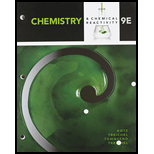
(a)
Interpretation:
The electronic configuration of
Concept introduction:
The electron configuration tells us in which orbitals the electrons for an element are located. Three rules are,
- Electrons fill orbitals staring with lowest n and moving upwards(Aufbau principle)
- No two electrons can fill one orbital with the same spin(Pauli Exclusion Principle)
- For orbitals within the same subshell, the electrons fill each orbital singly before any orbital gets a second electron (Hund’s rule).
Para magnetism refers to the magnetic state of an atom with one or more unpaired electrons.
Diamagnetism has no unpaired electrons (electrons are paired).
(a)
Answer to Problem 1PS
The electronic configuration of
Explanation of Solution
The electronic configuration of chromium is
(b)
Interpretation:
The electronic configuration of
Concept introduction:
The electron configuration tells us in which orbitals the electrons for an element are located. Three rules are,
- Electrons fill orbitals staring with lowest n and moving upwards(Aufbau principle)
- No two electrons can fill one orbital with the same spin(Pauli Exclusion Principle)
- For orbitals within the same subshell, the electrons fill each orbital singly before any orbital gets a second electron (Hund’s rule).
Para magnetism refers to the magnetic state of an atom with one or more unpaired electrons.
Diamagnetism has no unpaired electrons (electrons are paired).
(b)
Answer to Problem 1PS
The electronic configuration of
Explanation of Solution
The electronic configuration of vanadium is
(c)
Interpretation:
The electronic configuration of
Concept introduction:
The electron configuration tells us in which orbitals the electrons for an element are located. Three rules are,
- Electrons fill orbitals staring with lowest n and moving upwards(Aufbau principle)
- No two electrons can fill one orbital with the same spin(Pauli Exclusion Principle)
- For orbitals within the same subshell, the electrons fill each orbital singly before any orbital gets a second electron (Hund’s rule).
Para magnetism refers to the magnetic state of an atom with one or more unpaired electrons.
Diamagnetism has no unpaired electrons (electrons are paired).
(c)
Answer to Problem 1PS
The electronic configuration of
Explanation of Solution
The electronic configuration of nickel is
(d)
Interpretation:
The electronic configuration of
Concept introduction:
The electron configuration tells us in which orbitals the electrons for an element are located. Three rules are,
- Electrons fill orbitals staring with lowest n and moving upwards(Aufbau principle)
- No two electrons can fill one orbital with the same spin(Pauli Exclusion Principle)
- For orbitals within the same subshell, the electrons fill each orbital singly before any orbital gets a second electron (Hund’s rule).
Para magnetism refers to the magnetic state of an atom with one or more unpaired electrons.
Diamagnetism has no unpaired electrons (electrons are paired).
(d)
Answer to Problem 1PS
The electronic configuration of
Explanation of Solution
The electronic configuration of copper is
Want to see more full solutions like this?
Chapter 22 Solutions
Bundle: Chemistry & Chemical Reactivity, Loose-Leaf Version, 9th + OWLv2, 4 terms (24 Months) Printed Access Card
- Identify, based on the position in the periodic table, the actinide elements among those in the following list: Co, Cm, Cd, Ce, Cf.arrow_forwardWhich oxide, Mn₂O₃ or Mn₂O₇, is more basic in water?Why?arrow_forwardWhen orange solution containing Cr2O72–ion is treated with an alkali, a yellow solution is formed and when H+ions are added to yellow solution, an orange solution is obtained. Explain why does this happen?arrow_forward
- It has been observed that first ionization energy of 5 d series of transition elements are higher than that of 3d and 4d series, explain why?arrow_forward(a) What is the range in electronegativity across the first (3d)transition series? (b) What is the range across Period 4 of main-group elements? (c) Explain the difference.arrow_forwardWhat happens when transition metals are oxidized?arrow_forward
- What is the oxidation state of the metal centre in the [Cr(CO3)3(C6H6)] complex?arrow_forwardWhen cobalt(II) chloride is treated, under certain condition, with the bidentate ligand, NH2CH2CH2NH2, (which can be represented by the symbol “en”), the compound [CoC12(en)2]Cl is formed. a. What is the oxidation state of cobalt in the compound formed? b. What is meant by the term ‘bidentate’ as applied to a ligand?arrow_forwardThe coordination complex [Cr(CO)6] forms colorless, diamagnetic crystals that melt at 90 °C. Given that [Cr(CO)6] is colorless, would you expect CO to be a weak-field or strong-field ligand?arrow_forward
- How do the transition metals in Period 4 affect the pattern ofionization energies in Group 3A(13)? How does this patterncompare with that in Group 3B(3)?arrow_forwardWhich oxide, CrO₃ or CrO, is more acidic in water? Why?arrow_forwardPlatinum(II) forms many complexes, among them those with the following ligands. Give the formula and charge of each complex. (a) two ammonia molecules and one oxalate ion (C2O42-) (b) two ammonia molecules, one thiocyanate ion (SCN-), and one bromide ion (c) one ethylenediamine molecule and two nitrite ionsarrow_forward
 Chemistry: The Molecular ScienceChemistryISBN:9781285199047Author:John W. Moore, Conrad L. StanitskiPublisher:Cengage Learning
Chemistry: The Molecular ScienceChemistryISBN:9781285199047Author:John W. Moore, Conrad L. StanitskiPublisher:Cengage Learning Chemistry: Principles and ReactionsChemistryISBN:9781305079373Author:William L. Masterton, Cecile N. HurleyPublisher:Cengage Learning
Chemistry: Principles and ReactionsChemistryISBN:9781305079373Author:William L. Masterton, Cecile N. HurleyPublisher:Cengage Learning Chemistry: Principles and PracticeChemistryISBN:9780534420123Author:Daniel L. Reger, Scott R. Goode, David W. Ball, Edward MercerPublisher:Cengage Learning
Chemistry: Principles and PracticeChemistryISBN:9780534420123Author:Daniel L. Reger, Scott R. Goode, David W. Ball, Edward MercerPublisher:Cengage Learning Chemistry & Chemical ReactivityChemistryISBN:9781337399074Author:John C. Kotz, Paul M. Treichel, John Townsend, David TreichelPublisher:Cengage Learning
Chemistry & Chemical ReactivityChemistryISBN:9781337399074Author:John C. Kotz, Paul M. Treichel, John Townsend, David TreichelPublisher:Cengage Learning



